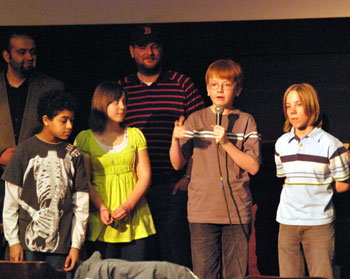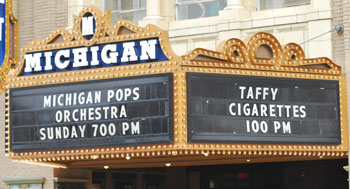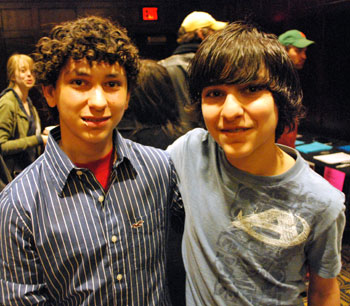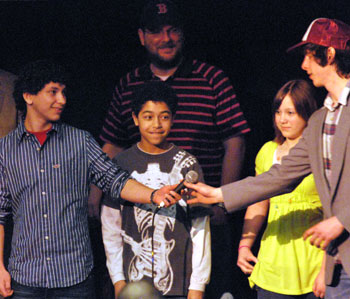Column: Taffy, Cigarettes, No Ill EFEX
Marty Stano, director of the film “Taffy, Cigarettes,” called The Chronicle a couple of weeks ago – he wanted to know if we’d be interested seeing a screener DVD of the 12.5-minute effort in advance of its premiere on Sunday, April 5 at the Michigan Theater.
The name “Stano” sounded familiar. I’d seen it somewhere. Ah yes, I’d edited a piece for The Chronicle on the 2009 Millers Creek Film Festival – Stano won an award for his “Runoff Lemonade.”
So, sure, I’ll look at a screener DVD from an award-winning director.
Whereas the Millers Creek submission seemed to be more of an independent effort, “Taffy, Cigarettes” – written and directed by Stano – was produced as part of the EFEX project: Encourage the Film-making Experience.
At Sunday’s premiere, the founders of EFEX – University of Michigan grad Sultan Sharrief and senior lecturer in screen arts and culture at UM Terri Sarris – were on hand to talk about the program’s goals: To provide through filmmaking “a comprehensive approach to teach young people how to live prosperous, socially valuable lives and to provide pathways to diversity in higher education.” EFEX is a collaboration between Sharrief’s production company, Beyond Blue, and the University of Michigan.

Actors from "Taffy, Cigarettes" left-to-right at the premiere: Adam Alpert, Lauren Jane Bryden, Zach Goldasich, Jack Meluch.
As he created the film”Taffy, Cigarettes” from the script he’d written, Stano – a UM grad himself – worked with students from Sarris’ film class and partnered with metro Detroit high school students. The script evolved in part through “workshopping” it at Belleville and Van Buren high schools. That entailed dividing up roles and just reading through the parts – a “table read” – then discussing whether it rang true. Auditions resulted in casting of Atif and Omar Hashwi, two brothers from Dearborn, in the roles of two bullies, Jake and Jimmy.
In the film, Jake and Jimmy antagonize two friends, Kevin and Travis, played by Jack Meluch and Adam Alpert, who are spending a summer playing baseball, playing pogs, and collecting empty pop bottles, before starting middle school in the fall. Stano describes the film as a coming-of-age story, which is also reflected in the tagline on the poster: “Childhood has to end sometime.”
And the film certainly works at that level. Kevin goes from getting shoved to the ground by Jake out on the train tracks and getting the cigarettes he’s bought for his mom stolen, to wielding a pop bottle with startling effectiveness in the final scene. This theme is supported with attention to detail throughout. The graffiti on the railroad bridge was added by the film crew and includes “Jake” in the design, marking the tracks as a place controlled by Jake and his brother. At the Q & A session after the premiere, Sarris stressed that she’d insisted on water-soluble paint – consistent with the general principle of not leaving a mess at places where they’d filmed.
It’s this notion of place explored by the film that’s more interesting to me than the coming-of-age theme. Who controls what place?
The hangout in their tree with the stash of money from pop bottles is Kevin and Travis’ place. The convenience store is Sid, the owner’s, place – where he closely monitors Kevin’s cigarette purchases. The railroad tracks and the playground – or really any place they happen to be – are places controlled by Jake and Jimmy. Kevin’s house is his mom’s place. The trampoline is Sarah’s place.
As I pre-screened the film, it’s the idea of place that lept first to mind, because I recognized so many of the places in the film – it was shot in Ann Arbor.
Even on the small-screen of my MacBook, when Wurster Park appeared in the background as Travis gave Kevin a ride on his bicycle pegs, it gave me a little thrill, because I recognized it as a place only three blocks away from where I live.
The thrill was repeated at the premiere and was amplified by the size of the image projected on Michigan Theater’s screening room.
What kind of place is my neighborhood? In “Taffy, Cigarettes,” it’s a place where kids get duct-taped to playground poles.
The duct-taping scene is presented in an understated, matter-of-fact way. Kevin and Travis look on with interest as the hapless victim gets strapped to the pole, but there’s no discernible inclination to intervene on his behalf. It’s apparently par-for-the-course. Par-for-the-course that the bullies duct-tape kids to poles. And par-for-the-course that Kevin and Travis look on passively. Later, we see the evidence of duct-taped kid’s eventual freedom in the form of duct-tape remnants still stuck to the pole, but how he escaped is left to our imagination.
In this, the film succeeds in Stano’s stated goal not to present its themes in a way that hits you over the head. Literal hitting-over-the-head, however, appears in the final scene.
Though the actor who endured the duct-taping said at the premiere he’d happily work with director Stano again, about the duct-tape he allowed, “It burns!”
I felt a delightful disconnect between the peaceable place I imagine my neighborhood to be and the idea that it’s a place where kids can get duct-taped to a pole.
The film also drove home to me something I already knew about Ann Arbor as a place. It’s small. I noticed in the credits that special thanks was given to Laura Fisher. Like Stano’s, that’s another name I recognized as having a previous Chronicle connection – but of a different kind. Fisher minds the code and the styles for The Ann Arbor Chronicle website. I wondered why the filmmakers wanted to thank her. It turns out her thirteen-year-old son, Jack Meluch, plays Kevin in the movie.









GO MARTY!
Thanks for the great experience. Marty Stano is the MAN!!